Overclocking The AMD Ryzen APUs: Guide and Results
by Ian Cutress & Gavin Bonshor on April 16, 2018 2:30 PM ESTHow to Overclock With MSI UEFI BIOS
The MSI UEFI BIOS is aesthetically pleasing and is easy to navigate around. The core features between the board being used for testing today, the MSI B350I Pro AC, and other models in their AM4 line up such as the X370 XPOWER GAMING TITANIUM are the same, with the same options for adjusting CPU core voltage, DRAM voltage and for the iGPU. It needs to be noted that the GFX Core voltage and CPU NB/SoC voltages are linked together; only one of them needs to be adjusted.
Hitting the Del key during system POST will get you into the first screen. The first screen is what MSI call ‘EZ mode’ which offers the basic panels for making minor adjustments.
Pressing F7 opens up the advanced section.
This offers high-level tabs for settings, OC and M-Flash. The overclocking panel is on the left, giving rise to the voltage parameters, CPU frequency multipliers, memory frequency, and the iGPU options.
On this particular board, all the options that need to be changed are all featured on the entry screen when the OC tab is selected. The CPU ratio can be adjusted by pressing +/- keys or by typing in a value. Voltage is in the Voltage Setting category a few options down, and is by default set to auto. For memory, XMP (shown as A-XMP) was set to profile 1 to enable DDR4-3333 mode.
The CPU core voltage options in the BIOS can only apply a maximum of 1.4 volts. Users looking to apply more can use the AMD Ryzen Master Utility which will allow for up to 1.55 V, although this is too much for ambient cooling and we would not recommend it. For our testing, this was set to 1.375 volts to match with our test setup and methodology settings. The memory voltage was manualy set to 1.35 volts to ensure it matched the specifications of our G.Skill Ripjaws DDR4’s first XMP profile.
Overclocking the graphics on our AMD Ryzen 3 2200G APU was also as easy as the rest, with the only settings needing changing is the GFX clock frequency, which we set to 1375 MHz.
When it comes to setting the voltages for the integrated graphics processor, the SoC voltage and the graphics voltage are linked, so changing one changes the other.
Once the settings are chosen, pressing F10 will bring up a summary of the changes made since the system was booted. Selecting yes will cause the system to reboot with the new settings.
Note: AMD’s Cool’n’Quiet function is automatically disabled on MSI motherboards when the CPU ratio is changed. Also, when OC explore mode is set from normal to expert, it opens up a setting called memory retry count. This is handy when manually overclocking memory as it will attempt to POST with a set variable amount, which automatically defaults at 5.


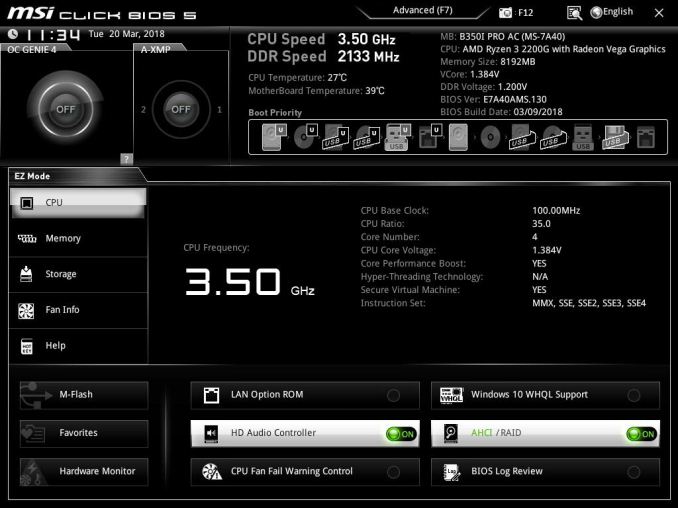
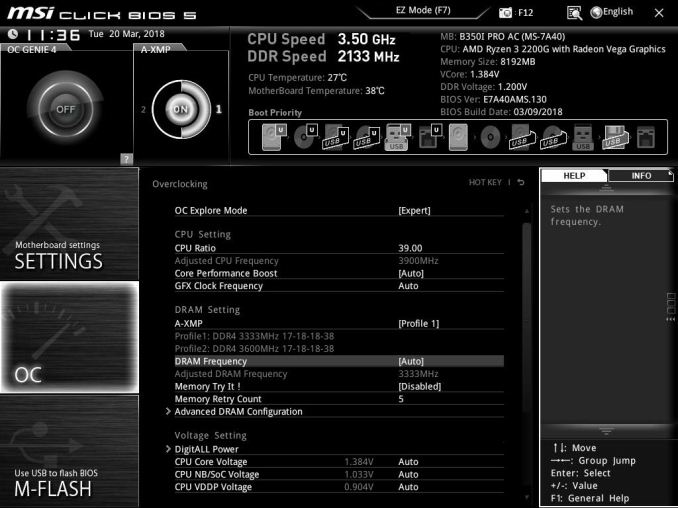
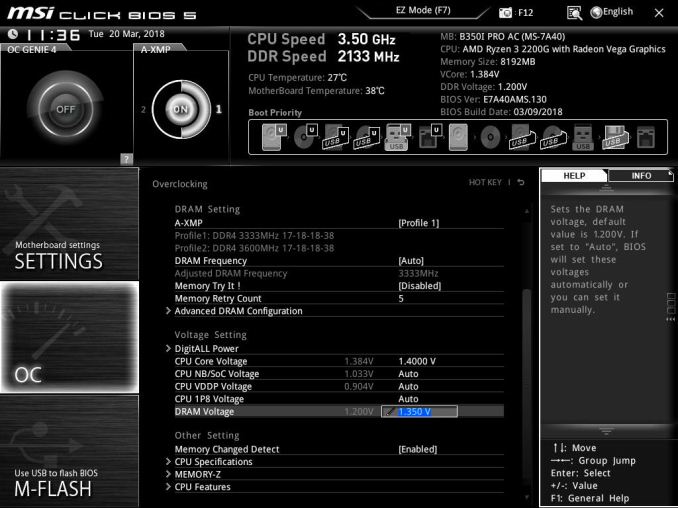
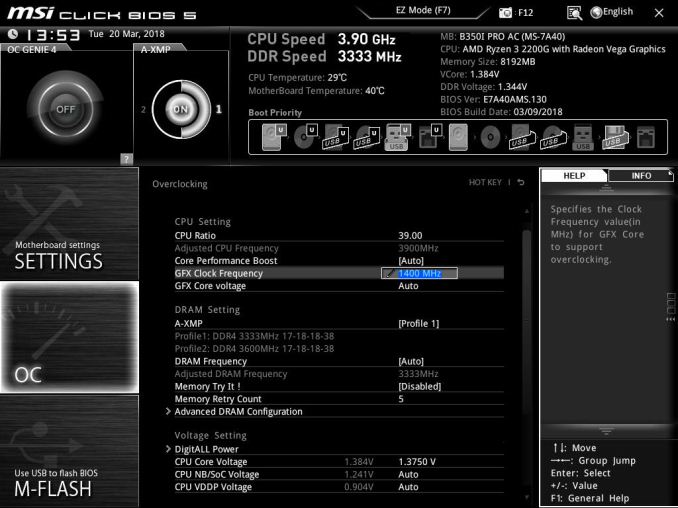
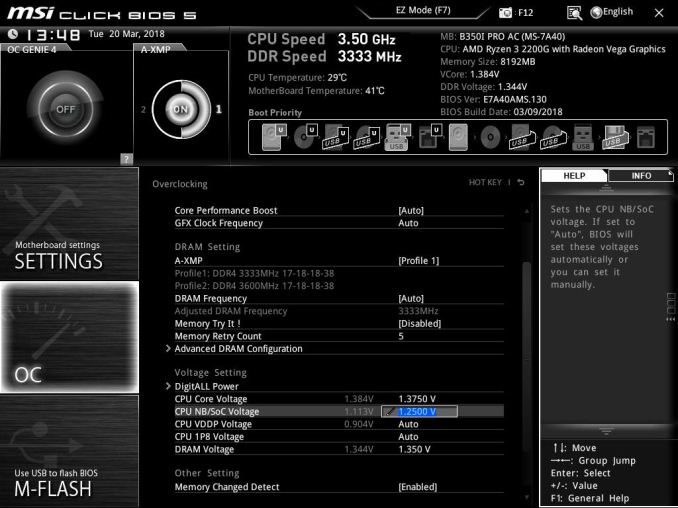
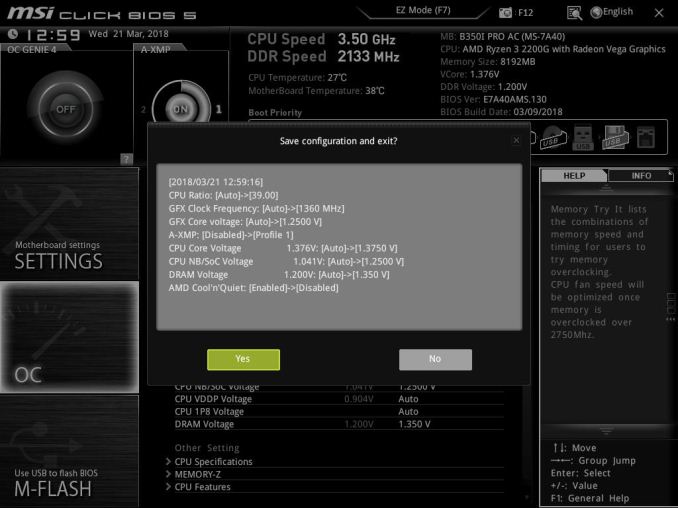








63 Comments
View All Comments
Eidorian - Monday, April 16, 2018 - link
Alarms were going off in my head when it says in the article that the E2160 was from 2005. I have July 26, 2006 seared into my memory as Core 2 Duo Day. I see the E2160 IHS does say '05.https://ark.intel.com/products/29739/Intel-Pentium...
Ian Cutress - Monday, April 16, 2018 - link
IHS says 05, ARK says Q3 '06, CPU-World says May 2017.http://www.cpu-world.com/Releases/Desktop_CPU_rele...
jjj - Monday, April 16, 2018 - link
Pretty sure retail was early June 2007 (certain about year) for the Allendale Pentiums.jjj - Monday, April 16, 2018 - link
Some folks found it in retail in late May 2007http://www.overclockers.com/forums/showthread.php/...
Eidorian - Monday, April 16, 2018 - link
That looks good.https://web.archive.org/web/20070927002239/http://...
nathanddrews - Monday, April 16, 2018 - link
That 2200G is quite the little spitfire, relatively speaking. Not sure I would spend extra money for a better cooler on a budget gaming build, though. I would put that money toward an SSD or maybe a FreeSync display and then overclock as best I could.coolhardware - Monday, April 16, 2018 - link
I'm going with a 2200G for my son's first PC build. I remember my Pentium II 233 build with the help of Anandtech WAY back in the day, complete with SCSI HDD. It was a sweet system that lasted a long time.Now, back the AMD build, any mobo recommendations? I would like to keep it mini-itx if possible and I am leaning toward the GIGABYTE GA-AB350N:
https://amzn.to/2HFQAoS (~$109) but am open to suggestions.
Reliability is top concern and two digital video outs (HDMI, or DisplayPort, not analog DSUB). Starting with the integrated GPU but maybe down the road going discrete.
Thanks in advance for advice! :-)
coolhardware - Monday, April 16, 2018 - link
PS I remember Anand posting SO MANY motherboard reviews back when he was just a kid (and so was I). Back then I settled on a Tyan motherboard after his recommendation. :-)RaduR - Tuesday, April 17, 2018 - link
Back old ViA MVP3 platform . Yes we were kids and Anand was actually working here !gavbon - Tuesday, April 17, 2018 - link
There will be many more to come, don't worry about that!